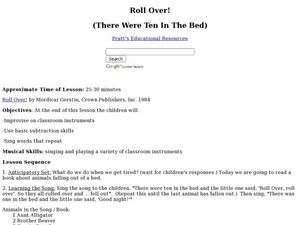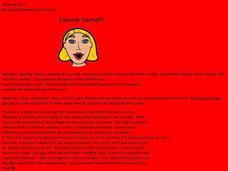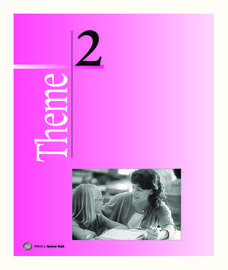Curated OER
Full Dolch Word List
Sight words are listed based on how frequently they are used. There are 250 words on the list. This would be a good, general resource for a teachers of grades 1 - 3. It is useful to know what words your class should know, and how well...
Curated OER
Vocabulary; Idioms/Phrasal Verbs Using Names of Animals,-Part 1
In this foreign language worksheet, students read ten sentences with missing words. They select the best word to fill in the blank from a list of three that are given. Each sentence contains an idiomatic phrase.
Curated OER
Itchy Iggy
First graders observe the letter /i/ and the sound that it makes watching their mouths as the sound is formed. They say the tongue twister displayed repeating it three times; the last time they stretch out the /i/ sound as it occurs in...
Curated OER
Match Words to Pictures
In this word recognition worksheet, 1st graders read 5 words and match them with their corresponding picture. Each word is only three letters.
Curated OER
Pansy Pig's Patience Pit
Students are introduced to the concepts of patience and anger. As a class, they are read a story about a patience pit and discover how anger can be controlled. They complete a worksheet and take a test to review how to control their...
Curated OER
The Big Pig
Students recognize the short vowel i in written and spoken language. Through matching activities, they discriminate the short vowel /i/ from other vowel sounds. Students associate the phoneme with its letter representation and identify...
Curated OER
Roll Over! (There Were Ten In The Bed)
Students practice math, language, and music skills. In this interdisciplinary lesson, students learn the song "Roll Over!" practicing repeating word patterns and subtraction skills. Students improvise in the song by adding various...
Curated OER
U.S. History Knowledge Test 3
In this U.S. history trivia worksheet, students answer twenty multiple choice questions based on their knowledge of U.S. history. This is an interactive worksheet.
Curated OER
What's the Price?
Fourth graders learn about price and comparative shopping. In this price and comparative shopping lesson, 4th graders read Amy Axelrod's, Pigs Go To Market: Fun with Math and Shopping. They use the book to investigate the meaning of...
Curated OER
Intervene or Interfere?
Learners research the motives, actions, and results of U.S. intervention in foreign affairs between the 1961 Bay of Pigs invasion and the 2003 invasion of Iraq.
Curated OER
Pet by Pet by Pet
In this ordinal number worksheet, 3rd graders examine the order of animals shown in a row at the top of the page. They answer questions that describe the position of each pet using ordinal numbers in 7 examples including 1 writing problem.
Curated OER
The Gingerbread Man
Students complete a variety of activities related to the Jan Brett version of the book "The Gingerbread Man." They compare and contrast two versions of the story, prepare and eat gingerbread cookies, describe their gingerbread man...
Curated OER
Express Yourself!
Students explore the five main components to reading fluency: faster reading, smoother reading, expressive reading, silent reading and voluntary reading. This lesson is designed to help children use expression as they read. Improvement...
T. Smith Publishing
Counting on the Farm
Hee-haw! Preschool or kindergarten math pupils identify and count different objects in a lively farm landscape. Beneath the picture, each animal or plant is represented pictorially, and little ones simply write the total count for each....
Curated OER
American Foreign Policy Since World War II (The Cold War)
High schoolers identify and interpret some key figures and major events during the Cold War era, including the Korean War, Vietnam, Cuban Missile Crisis, Bay of Pigs Invasion, and the United States and China Cold War Relations. They...
Curated OER
Lord of the Flies: Fun Trivia Quiz
Assess your class on Lord of the Flies with this basic comprehension quiz. This online quiz is composed of ten multiple choice and true/false questions about the characters and plot of the novel. Learners receive immediate feedback when...
Curated OER
Reading Comprehension-Grade 2
In this grade 2 reading comprehension worksheet, students read several short passages, answering 1-3 multiple choice comprehension questions after each. Answers are included.
Curated OER
A Day at the Fair
Students explore the American tradition of state and county fairs. For this American fairs lesson, students read an article about American fairs and complete a five senses table for experiences at fairs. Students role play a family...
Houghton Mifflin Harcourt
Nature Walk: Extra Support Lessons (Theme 2)
Reinforce concepts such as long vowels, spelling patterns, sound clusters, double-final consonants, and syllables with a nature-themed unit. Through a series of extra support lessons, learners compare and contrast using a Venn diagram,...
Florida Center for Reading Research
Phonics: Letter-Sound Correspondence, Medial Phoneme Spin
A collaborative activity challenges young scholars to match medial graphemes and phonemes. Pairs take turns spinning the spinner, naming the letter, and saying its name. They choose from a stack of cards with the same medial sound.
Curated OER
Comparing and Contrasting Literature Using Venn Diagrams
First graders create a venn diagram with two folktales. In this folktale activity, 1st graders read Cinderella and Mufaro's Beautiful Daughters by John Steptoe. They find the similarities and differences and chart these on a venn diagram.
Curated OER
Piggie Pie!
Students explain about their experiences on the farm and draw pictures to show what they know. Students read the recipe for the piggie pie that Gritch was going to use. Students estimate and then measure how many pigs it would take to...
Curated OER
Anatomy of the Heart
Tenth graders examine the different parts of the heart. In this biology lesson, 10th graders perform dissection of the fetal pig. They explain how the heart maintains homeostasis.
Curated OER
Lines, Rays, and Angles
Third graders read "Pigs on the Ball" by Amy Axelrod and discuss the geometry concepts presented in the book. They use Twizzler sticks and pipe cleaners to represent lines, rays and angles.

























